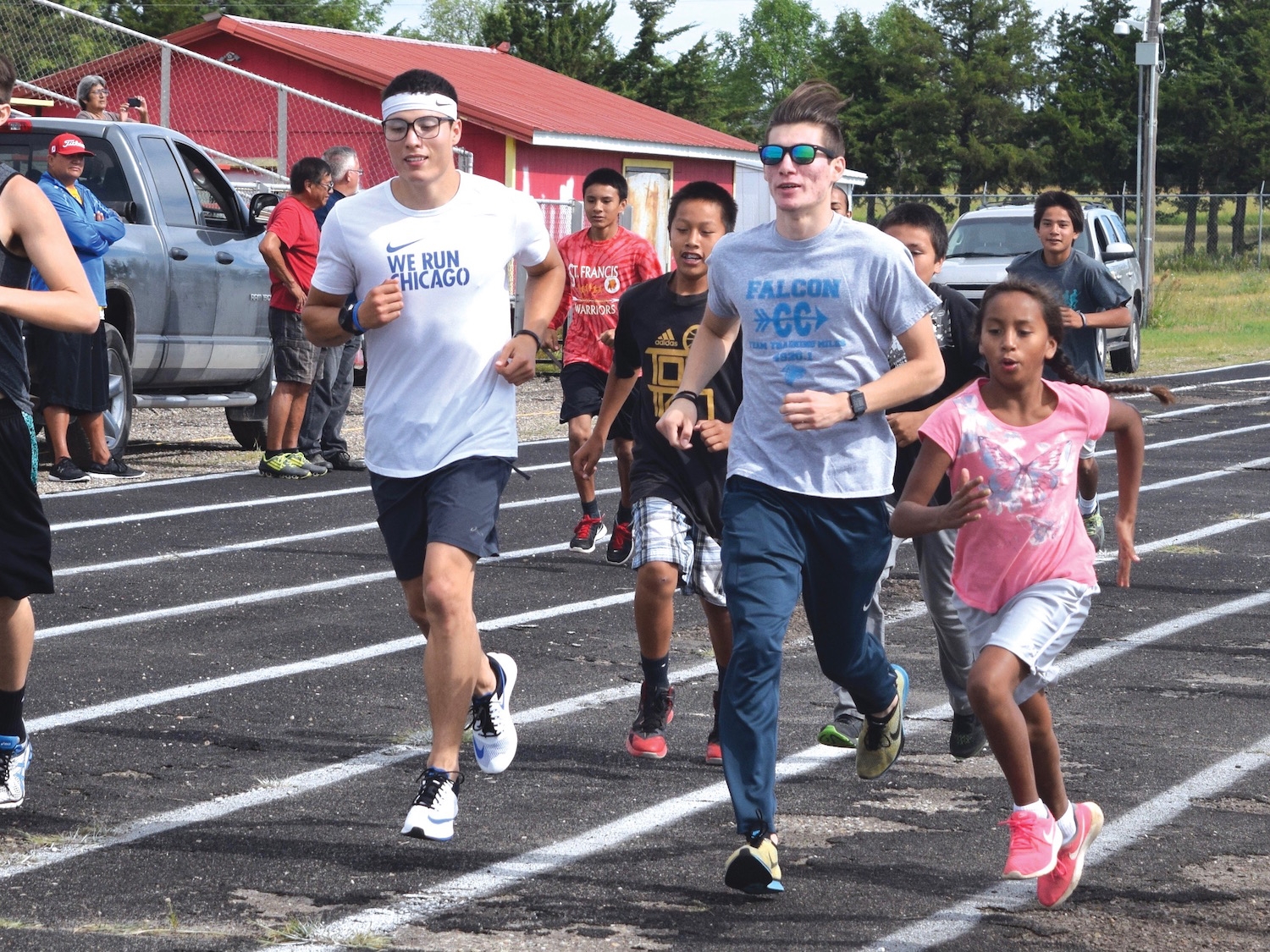
Robert Iron Shell, left, leads a warmup lap around the St. Francis football field to kick off his running clinic held there last Thursday. Photo by James Giago Davies
Iron Shell holds clinic at St Francis
Stresses dedication, discipline, training
By James Giago Davies
Native Sun News Correspondent
nsweekly.com ST FRANCIS –– Every person has a distance at which they run best. Since most of us never run competitively, we never find out what that distance is, it may be just from the couch to the refrigerator. Time and again Lakota prove their best distance covers miles. Billy Mills won a 10,000 meters gold medal at the Tokyo Olympic games in 1964. After 9,900 meters Mills had so much left he sprinted past the race favorites like they were turtles. When he was a boy at Rosebud elementary, Robert Iron Shell knew all about the exploits of celebrated Lakota distance runners. But he admits, “I am not a distance runner.” “A lot of people say I was fast,” Iron Shell says. “But if I was, it wasn’t crazy fast.” Not competitive over distance, and not crazy fast in a sprint, there was no reason for people to think Iron Shell would ever be a track athlete of note. Yet, a decade after his family relocated in western Iowa, Iron Shell has transformed himself into the fastest Indian on earth. Not over distance, but over 400 meters, a distance few Indians have had success at since the time of Jim Thorpe and Fait Elkins, almost a century ago. There is a reason why you don’t see many Indian sprinters. The physiology of most Lakota has a unique signature. An unusual combination of fast twitch and slow twitch muscle fibers seldom found in the general population. Slow twitch fibers provide, endurance, and performance over long distances, and when coupled with large lungs and a slow heart rate, they supplied Billy Mills with the gifts he needed to help win in Tokyo. Because Mills didn’t win in Tokyo by sticking to that formula alone. He won by sprinting past his competitors who lacked the fast twitch fibers Mills had in his body. These fast twitch fibers gave Mills the foot speed he needed to beat distance runner competition, but they were not enough for him to ever successfully compete at any distance under a half mile. Iron Shell is a sprinter, not a 100 meters sprinter, although his top 100 meters time of 10.4 is nothing to sneeze at, but at the 200 and 400 meter distances, because where most sprinters start to lock up, their fast twitch fibers screaming for fuel their body can no longer supply, Iron Shell has enough of his Sicangu ancestor’s slow twitch fibers to maintain form, and speed, clear around a half mile track. The result is a 47 second performance, which allowed him to finish third at the NAIA nationals in 2015 for Sioux City, Iowa’s Briar Cliff College. Iron Shell is a natural quarter miler, and so if his refrigerator was located a quarter mile from his couch, it would not be nearly as inconvenient for him as it would be for us. That doesn’t mean he just pranced out onto the track one day and lit it up for 400 meters. “When I tried out in middle school,” Iron Shell says, “I didn’t make the track team.” If he had any talent for the quarter mile it certainly didn’t impress people in his first races: “I ran my first 400, and I got around 200, and I just pooped out. When you run the 400 your butt just feels like it’s on fire.”

Read the rest of the story on the all new Native Sun News website: Iron Shell holds clinic at St Francis (Contact James Giago Davies at skindiesel@msn.com) Copyright permission Native Sun News Native Sun News: Rosebud Sioux student earns top athletic award (06/09)
Join the Conversation
